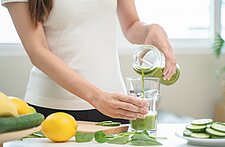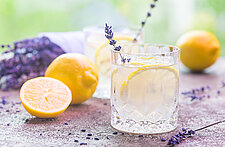By Junior Merino and Ramin Ganeshram
The idea of a sophisticated, non-alcoholic pre-dinner drink isn’t a new one. In the 1800s, juice “squashes” and vinegar-based “shrubs” were popular alcohol-free options for ladies even while men continued to sip their brandy and bourbons. And, while the Volstead Act prohibiting alcohol in the United States from 1919 to 1933, rose the cocktail to new splendor in underground speakeasies, mock cocktails for those who supported the law offered a sophisticated version that any tea-totaller could enjoy.
Although today we enjoy cocktails freely, sometimes the time just isn’t right for a cocktail--you may be the designated driver or simply a non-drinker. Either way, you might wonder about the perfect substitution for that delicious cocktail your friend is sipping on and if you did, you’d be thinking of a mocktail.
CLICK HERE to view Monthly Mixology: Gin
While mocktails have been around for a long time, food historians think the name an abbreviation of a “mock cocktail” was likely coined sometime in the 1980s. These non-alcoholic party drinks come in a ton of varieties and whether you prefer frozen, hot, fizzy, or creamy there’s one for you. You may have already tried one if you’ve had a virgin piña colada. Other popular mocktails are the Classic Shirley Temple, Rob Roy, Virgin Mary, NO-jito, and everyone’s favorite mocktail- the Arnold Palmer.
Since 2000, mocktails have been popular and well integrated on my own cocktail menus. Using only the freshest fruits, vegetables and organic syrups, our award-winning mocktails are created with the same high standards as our cocktail creations. One of my favorite summer drinks is a mocktail I call “The Sparkler”: Take 2 slices of English cucumber, basil leaves, and our agave nectar, and muddle them together. Add grapefruit juice, lemon juice and club soda. The tart combination of the lemon juice and pink grapefruit is perfectly complimented with agave nectar for a sophisticated sweet-sour balance.
Rising Mocktail Searches on Google:

Mocktails are fun and healthy recipes that can be enjoyed—and made by--anyone. Many of the ingredients for a great mocktail are right in your own kitchen. Some common building blocks for a superior mocktail are orange juice, chilled ginger beer, aloe vera juice, club soda, lemon/lime juice, coconut milk, and ice. Enhance flavor by adding herbs, spices or berries that either compliment or create a unique taste profile. Like their alcoholic counterparts, mocktails can be blended or shaken in a Boston shaker and made iced or neat—the format is up to you. Experiment to your heart’s content—after all it’s your drink!
Click Here to check out Monthly Mixology: Blooming Botanicals
Mocktails 101
- As an adult, Shirley Temple thought the drink named for her was too sweet and syrupy. To avoid that error in your own mocktails always keep balance in mind when you combine your ingredients. You don’t want your mocktail to overpower on sweetness or sourness.
- Consider what elements alcohol brings to a cocktail such acidity, dryness, and tartness and seek substitutes that can provide similar profiles such as citrus juice, unsweetened hibiscus tisane, teas or even light application of artisan vinegars.
- Remember that dried herbs are much more intense than fresh ones, so adjust measurements accordingly.
- Experiment within a flavor “family”. For example, basil and mint are in the same family, substituting one for the other can change the mocktail into something unique. Warm spices like cinnamon, allspice, clove, ginger, and nutmeg combine well but also can replace each other in the right drink.





